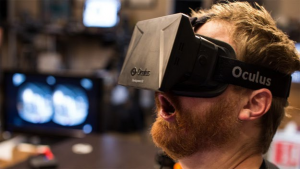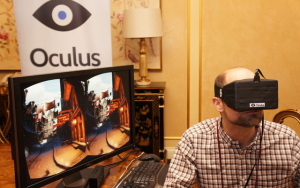Oculus Rift Rumors & News Roundup: Release Date, Specs, and Features
If you're like me and 90% of the rest of the techies out there, you've probably been intrigued by all the recent news about virtual reality, and you've undoubtedly heard about the legendary Facebook-owned Oculus Rift headset that has supposedly “solved the virtual reality problem.”
We're all waiting on the headset to hit stores so we can camp outside for ten days and form two-block lines to get our hands on one, but in the meantime, there are news stories about the Rift popping up everywhere.
In fact, there's so much buzz about this device that it's become hard to keep track of everything going on, and it's fairly difficult to find a page that will tell you everything you need to know without you having to search the web for a dozen different stories.
Fortunately, you've found the one page that will save you all that researching hassle, because in the following paragraphs we're going to discuss (and link to) everything you need to know about the Oculus Rift:
Features and Specs
First, the Rift can be accurately described as a headset equipped with a built-in virtual reality display that immerses the wearer in a virtual environment by engulfing their field of vision in HD 3D imagery. The included headphones further bolster the realism of the experience by complimenting the visual side with life-like audio.
According to the official site, the Rift produces stereoscopic 3D views that have “depth, scale, and parallax” and are split into two “unique and parallel” images in order to provide an experience that s closer to the way your eyes perceive reality than the type of 3D seen in movies.
The Rift creates a field of view that “stretches beyond your peripheral vision” and uses head-tracking technology to allow you to run your head and look around the virtual world accurately, without experiencing the motion sickness problems that classic VR attempts produced.
The original prototype used a 5.6-inch screen in the headset, but the currently distributed developer's kit has a 7-inch screen. Furthermore, the latest prototype also has a better pixel fill (making individual pixels less noticeable and eliminating the screen door effect), the LCD is brighter, the color depth is higher (at 24 bits/pixel), and has a lower pixel switching time, which greatly reduces motion blur and latency.
The upgrade to a 7-inch screen fixed the overlapping stereoscopic 3D problem, and the device's 110 degree diagonal field of view (FOV) is twice the FOV of most other VR devices. In fact, the massive field of view and the 3D head-tracking are probably the two strongest points of the technology.
Originally the resolution numbers seemed kind of low at first glance at only 1280 x 800 at a 16:10 aspect ratio. Effectively that equates to 640x800 resolution at a 4:5 aspect ratio in each individual eye. However, because the image is so close to the user's face and because it does not overlap between the user's eyes, the effect gave an image quality that appeared to be much higher than 640p.
Fortunately, a 1080p version of the Rift was revealed in June, 2013, and the second generation developer's kit (DK2) released in July 2014 boasted a more impressive resolution of 960x1080 per eye with a low-persistence pentile AMOLED display. DK2 also introduced a higher refresh rate, positional head tracking, and the omission of the previously needed external control box, making the Rift a fully self-contained VR platform.
For a more thorough overview of the Rift's history and features, we recommend a quick read of the Oculus Rift Wikipedia page.
Development News, Price, and Release Date
If you want to know where the project all started and a learn a bit about the history of VR and the Rift, we recommend Wired's Inside Story of How the Ocuslus Rift and Virtual Reality Became Reality.
Surprisingly, the Oculus Rift is expected to debut in the shockingly affordable $200 price range. That's about half the cost of a conventional gaming console and yet it promises to deliver a gaming experience that is far superior.
As far as the release date is concerned, most pundits have projected a probable launch at some point between September and December 2015, just in time for the holiday buying season. It is also possible that the launch could happen a bit sooner, towards the middle of 2015.
If reviews of the latest prototype provide any indication, the only phase left should be manufacturing and distribution, as the Rift seems to already have what it needs to impress consumers as it has the dozens of lucky techies that have been privileged enough to give it a test drive. But if the Rift is already so great, why not go ahead and release it the general public now? While the hardware itself seems to be ready for launch, Oculus VR doesn't want to release the product until there are a enough games and content to make it an appealing purchase for consumers.
The latest updated prototype of the Rift was introduced in September 2014 and is going by the codename 'Crescent Bay', which has a higher resolution, high-quality built-in audio, and 360-degree head tracking facilitated by tracking LEDs position in the rear of the headset.
Overall, most analysts expect the release date to come at some point in 2015, as Business Insider has already reported that the Oculus team would be highly disappointed if the release date was postponed to 2016.
If you'd like to see the Oculus Rift in action, there's no shortage of videos and blog posts showing off the device being test-driven by enthusiastic and awe-stricken techies. For example, PCWorld did an excellent piece on ten experiments that prove the Rift's practical potential.
Other Interesting Rumors and News
The True “Next Generation” in Gaming Realism
We've all reamed about the day we could wonder through awesome game land in virtual reality, escaping the boring confines of our mundane living rooms and entering into a whole new realm. While this might all sound like marketing hyperbole, according to some avid gamers who've had the chance to test out some of the titles already available for the Rift prototype, the gaming experience in VR is unlike anything that anyone could prepare themselves for.
Games in VR apparently become closer to actual simulations, so emotional and physical stimulation is excited to a much higher degree, as the player is no longer watching the game, they're becoming a part of it. A prime example of a first-hand account of this would be Chris Kohler's review of Alien: Isolation on Wired.com, in which he describes being actually terrified and exhilarated in the game, even touting the ultra-real experience as the game that “nearly destroyed” him.
What Will The Rift Do For Movies?
Last year an editor at Wired.com named Angela Watercutter published a piece with the headline proclaiming that the Oculus Rift is “the future of movies.” At that point that assumption was being made after the Wired editor watched a Beck concert in the Rift.
Later that in 2014 it was then announced that the first movie made for the Oculus Rift is a horror film called the Banshee Chapter, which surprisingly enough is a low budget film that was originally revealed in non-virtual reality in December of 2013.
A couple months prior to the original release of that film that nobody has heard of, in October of 2013, an editor at Kotaku was complaining about how horrible it was to watch regular movies on the Rift. Luckily, Oculus VR has since released updated version that offer higher resolution and low-persistence displays to reduce pixelation and eye strain.
Thus, that review of Rift movie-watching should be seen as outdated and irrelevant when discussing what it's going to be like watching movies that are actually made to be shown in stereoscopic 3D within a VR headset.
As we can gather from Angela's more recent review of a VR concert, the Rift has a come a long way in just one year, and VR-tailored content really does make a difference in comparison to watching standard 2D content in a VR headset, which some would say is a gross misuse of the product anyways.
The Rift and VR Could Change Marketing and Advertising Forever
Then there's the marketing implications that the Oculus Rift presents. Imagine the type of advertisements that can be displayed in VR, and how enticing or persuasive those ads might be. At the moment it costs about $1 million to produce a 3-minute advertisement in VR, but as time passes those costs will inevitably decrease as the technology becomes more widely available and further developed.
All of this burdens us with the question: “If Facebook invested $2 billion into the Oculus Rift, what might other brands pay for the production and distribution of advertisements in the VR realm. The prospect of 3D, 360-degree commercials certainly seems appealing not only form an advertiser standpoint but also form the perspective of a consumer looking for maximum entertainment value.
While we can all say that we'd prefer not to have ads in our games and TV shows, we're sure nobody would be upset with the visual awesomeness of a 3D commercial in VR – it would only add to the experience. Eventually, after people get used to viewing the VR realm, the commercials would again be unwanted, but by that time the shift int he marketing paradigm will already have occurred.
The Rift and Social Networking
Speaking of Facebook's acquisition of the Oculus Rift, what better way to close this rumor & news roundup than to discuss what the original inventor of the Rift has called the future of virtual reality: social networking. The communication possibilities that VR represents are absolutely amazing, which is probably why Mark Zuckerberg and his company took such interest in the headset and were willing to invest in it.
IBTimes later interviewed Zuckerberg about the reasons why he decided to buy Oculus VR. IN the interview Mark reiterated his three primary goals for Facebook – connect everyone, build the “knowledge economy,” and understand the world.
We also know that Facebook is interested in the development of artificial intelligence. Imagine how much the Rift could aid Facebook in creating AI when they can use the headset to analyse what people look at, how they behave, and how they respond to actions in the virtual realm.


